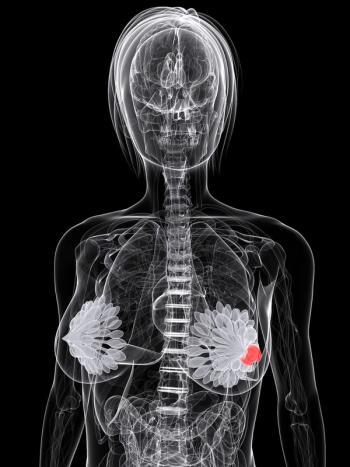
Belantamab Mafodotin Combos Receive EU Approval for R/R Multiple Myeloma
Phase 3 DREAMM-7 and DREAMM-8 trial results showed that combinations with belantamab mafodotin showed superior efficacy vs standard of care in the disease.
The EU has approved 2 belantamab mafodotin-blmf (Blenrep)-based combinations for the treatment of patients with relapsed/refractory multiple myeloma, according to a news release from the drug’s developer, GSK.1 Specifically, the approval included a combination therapy with bortezomib (Velcade) and dexamethasone (BVd) for the treatment of patients who have received at least 1 prior therapy, and in combination with pomalidomide (Pomalyst) plus dexamethasone (BPd) in patients who have received 1 or more prior therapies, including lenalidomide (Revlimid).
Support for the decision is based on results from the
DREAMM-7
Phase 3 DREAMM-7 trial data published in the Journal of Clinical Oncology revealed that among those treated in the study, the median progression-free survival (PFS) was 36.6 months (95% CI, 28.4-not reached [NR]) in the BVd arm vs 13.4 months (95% CI, 11.1-17.5) with daratumumab (Darzalex) plus bortezomib and dexamethasone (DVd; HR, 0.41; 95% CI, 0.31-0.53; P <.00001).2 The 18-month PFS rates were 69% and 43% in the respective arm.
Furthermore, findings from an overall survival (OS) analysis presented at the
The objective response rate (ORR) in the BVd and DVd arms were 83.1% (95% CI, 77.8%-87.6%) vs 71.3% (95% CI, 65.3%-76.8%). Furthermore, the median DOR in each respective arm was 40.8 months (95% CI, 30.5-NR) vs 17.8 months (95% CI, 13.8-23.6).
Patients 18 years and older in the trial were randomly assigned 1:1 to receive BVd or DVd. Those in the investigational arm received 2.5 mg/kg of intravenous belantamab mafodotin every 3 weeks with bortezomib and dexamethasone and 16 mg/kg of intravenous daratumumab weekly for cycles 1 to 3 and every 3 weeks from cycles 4 to 8. For cycles 9 and beyond, patients received 2.5 mg/kg of intravenous belantamab mafodotin every 3 weeks or 16 mg/kg of intravenous daratumumab every 4 weeks.
In the trial, any-grade adverse effects (AEs) occurred in all patients in the BVd and DVd arms, with 100% of AEs in the BVd arm and 95% of AEs in the DVd arm related to study treatment. Grade 3 or 4 AEs occurred in 95% and 78% of the respective patient groups.
Dose delays or reductions related to AEs occurred in 95% and 75% of the BVd arm, respectively, vs 76% and 59% in the DVd arm. AE-related discontinuations occurred in 32% and 19% of the respective arms. Serious AEs occurred in 21% and 13% of patients in each arm, respectively, 11% and 8% of which were fatal.
DREAMM-8
Efficacy data from the phase 3 DREAMM-8 trial published in the Journal of Clinical Oncology revealed that the median PFS was NR (95% CI, 20.6-NR) in patients treated with BPd compared with 12.7 months (95% CI, 9.1-18.5) among those treated with DVd (HR, 0.52; 95% CI, 0.37-0.73; P <.001), with respective 12-month PFS rates of 71% and 51%.4 The ORR in the respective arms were 77% (95% CI, 70.0%-83.7%) and 72% (95% CI, 64.1%-79.2%).Additionally, the median DOR in each arm was NR (95% CI, 24.9-NR) vs 17.5 months (95% CI, 12.1-26.4).
Patients in the trial were randomly assigned to receive BPd or DVd. Patients in the BPD arm received 2.5 mg/kg of intravenous belantamab mafodotin on day 1, cycle 1 and 1.9 mg/kg of the agent on day 1 of subsequent cycles; 4 mg of oral pomalidomide taken days 1 to 21; and 40 mg of dexamethasone on days 1, 8, 15, and 22 of 28-day cycles.
Regarding safety, grade 3 or 4 AEs were observed in 91% of the BPd arm and 73% of the DVd arm. Furthermore, AEs led to discontinuation of any study treatment in 15% and 12% of the respective arms. Serious AEs occurred in 63% of the BPd and 45% of the DVd arms, of which 11% and 11% were fatal.
In November 2024, the FDA
On July 17, 2025, the FDA’s Oncologic Advisory Drug Committee (ODAC)
Additionally, the FDA has extended the review period for this indication. The new Prescription Drug User Fee Act date will be October 23, 2025.7
References
- Blenrep (belantamab mafodotin) combinations approved in EU for treatment of relapsed/refractory multiple myeloma. News release. GSK. July 24, 2025. Accessed July 24, 2025. https://tinyurl.com/5n9bh49c
- Mateos MV, Robak P, Hus M, et al. Results from the randomized phase III DREAMM-7 study of belantamab mafodotin (belamaf) + bortezomib, and dexamethasone (BVd) vs daratumumab, bortezomib, and dexamethasone (DVd) in relapsed/refractory multiple myeloma (RRMM). J Clin Oncol. 2024;42(suppl 36):439572. doi:10.1200/JCO.2024.42.36_suppl.439572
- Hungria V, Robak P, Hus M, et al. Belantamab mafodotin, bortezomib, and dexamethasone vs daratumumab, bortezomib, and dexamethasone in relapsed/refractory multiple myeloma: overall survival analysis and updated efficacy outcomes of the phase 3 DREAMM-7 trial. Blood. 2024;144(suppl 1):772. doi:10.1182/blood-2024-200336
- Trudel S, Beksac M, Pour L, et al. Results from the randomized phase 3 DREAMM-8 study of belantamab mafodotin plus pomalidomide and dexamethasone (BPd) vs pomalidomide plus bortezomib and dexamethasone (PVd) in relapsed/refractory multiple myeloma (RRMM). J Clin Oncol. 2024;42(suppl 17):LBA105. doi:10.1200/JCO.2024.42.17_suppl.LBA105
- Blenrep combinations accepted for review by the US FDA for the treatment of relapsed/refractory multiple myeloma. News release. GSK. November 25, 2024. Accessed July 24, 2025. https://tinyurl.com/4wjtdf3t
- July 17, 2025, Meeting of the Oncologic Drugs Advisory Committee (ODAC). FDA. Streamed live July 17, 2025. Accessed July 24, 2025. https://tinyurl.com/mhafuuy8
- GSK announces extension of US Food and Drug Administration review period for Blenrep (belantamab mafodotin-blmf) in relapsed/refractory multiple myeloma. News release. GSK. July 23, 2025. Accessed July 23, 2025. https://tinyurl.com/43fmhzt7
Newsletter
Stay up to date on recent advances in the multidisciplinary approach to cancer.
















































































